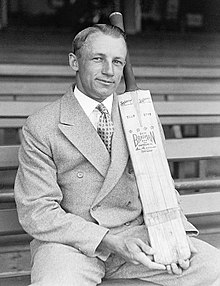
Back ১৯৪৮ সালে ইংল্যান্ডে ডন ব্র্যাডম্যান অস্ট্রেলীয় ক্রিকেট দলের সাথে Bengali/Bangla ഡോൺ ബ്രാഡ്മാനും 1948ലെ ആസ്ട്രേലിയയുടെ ഇംഗ്ലണ്ട് പര്യടനവും Malayalam
An editor has nominated this article for deletion. You are welcome to participate in the deletion discussion, which will decide whether or not to retain it. |
 | ||||||||||||||||||||||||||||||||||||||||
| Personal information | ||||||||||||||||||||||||||||||||||||||||
|---|---|---|---|---|---|---|---|---|---|---|---|---|---|---|---|---|---|---|---|---|---|---|---|---|---|---|---|---|---|---|---|---|---|---|---|---|---|---|---|---|
| Full name | Sir Donald George Bradman | |||||||||||||||||||||||||||||||||||||||
| Born | 27 August 1908 Cootamundra, New South Wales, Australia | |||||||||||||||||||||||||||||||||||||||
| Died | 25 February 2001 (aged 92) Kensington Park, Adelaide, Australia | |||||||||||||||||||||||||||||||||||||||
| Nickname | The Don, The Boy from Bowral, Braddles | |||||||||||||||||||||||||||||||||||||||
| Height | 1.70 m (5 ft 7 in) | |||||||||||||||||||||||||||||||||||||||
| Batting | Right-handed | |||||||||||||||||||||||||||||||||||||||
| Bowling | Right-arm leg break | |||||||||||||||||||||||||||||||||||||||
| Role | Batsman | |||||||||||||||||||||||||||||||||||||||
| International information | ||||||||||||||||||||||||||||||||||||||||
| National side | ||||||||||||||||||||||||||||||||||||||||
| Test debut | 10 June 1948 v England | |||||||||||||||||||||||||||||||||||||||
| Last Test | 14 August 1948 v England | |||||||||||||||||||||||||||||||||||||||
| Career statistics | ||||||||||||||||||||||||||||||||||||||||
| ||||||||||||||||||||||||||||||||||||||||
Don Bradman toured England in 1948 with an Australian cricket team that went undefeated in their 34 tour matches, including the five Ashes Tests. Bradman was the captain, one of three selectors, and overall a dominant figure of what was regarded as one of the finest teams of all time, earning the sobriquet The Invincibles.
Generally regarded as the greatest batsman in the history of cricket, the right-handed Bradman played in all five Tests as captain at No. 3. Bradman was more influential than other Australian captains because he was also one of the three selectors who had a hand in choosing the squad. He was also a member of the Australian Board of Control while still playing, a privilege that no other person has held. At the age of 40, Bradman was by far the oldest player on the team; three-quarters of his team were at least eight years younger, and some viewed him as a father figure. Coupled with his status as a national hero, cricketing ability and influence as an administrator, this associated the team more closely to him than other teams to their respective captains. Bradman's iconic stature as a cricketer also led to record-breaking public interest and attendances at the matches on tour.
Bradman ended the first-class matches atop the batting aggregates and averages, with 2428 runs at 89.92, and eleven centuries, the most by any player. Despite his success, his troubles against Alec Bedser's leg trap—he fell three consecutive times in the Tests and twice in other matches to bowlers using this ploy—were the subject of much discussion.
Bradman scored 138 in the first innings of the First Test at Trent Bridge, laying the foundation for Australia's 509, which set up a lead of 344 and eventual victory. In the Fourth Test at Headingley, he scored an unbeaten 173 on a deteriorating pitch on the final day, combining in a triple-century partnership with Arthur Morris as Australia scored 3/404[1] in the second innings to win by seven wickets. This set a world record for the highest ever successful run-chase in Test history. The tour was Bradman's international farewell, and when needing only four runs for a Test career average of exactly 100, he bowed out with a second ball duck in the Fifth Test at The Oval, bowled by an Eric Hollies googly. Australia nevertheless won the Test to complete a 4–0 series win, and Bradman ended the series with 508 runs at 72.57, with two centuries. Only Morris—with three centuries—scored more runs in the five Tests. Bradman's Test average for the series was the third-highest among the Australians, behind that of Sid Barnes and Morris.
© MMXXIII Rich X Search. We shall prevail. All rights reserved. Rich X Search